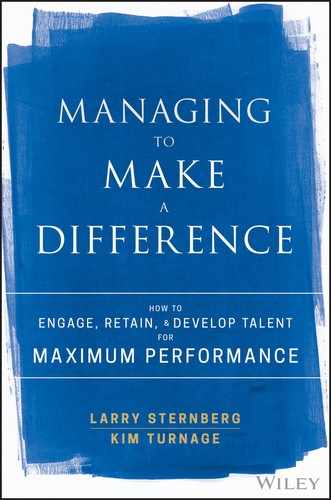Chapter 50
Provide Frequent, Candid Feedback
Managers often ask how they can create a culture of feedback. Feedback is a tried and true mechanism for enhancing performance. What gets measured gets done. What gets measured and rewarded gets done better and more often (and more willingly). Ask yourself these questions about how you are providing feedback to the people you manage:
- How frequently do you provide feedback to the people on your team?
- Do they know what you expect?
- Do they know how they are doing?
- How long is the lag between their performance and your feedback?
- How do people feel about your feedback? Do they look forward to feedback from you or do they dread it?
- In your culture, is feedback a normal part of the regular routine, or is it a once a year occurrence?
Here is a story about how one manager made progress on creating a culture of feedback:
As he assessed the situation with his new team, Frank saw something that none of the other leaders in the hotel realized. There was no measurement system in place for housemen. Frank knew that feedback would improve performance, but he lacked a foundation for providing consistent, useful feedback. So he created one, and he demonstrated that building a culture of feedback has the potential to bring about serious improvements in performance, retention, and engagement.
These days, because almost everybody has a smartphone, it is easier to get feedback from end users. To evaluate banquet housemen today, we could ask meeting attendees or the meeting planner to answer one or two questions on their phones about the room setup. These ratings would evaluate performance, and they might even be better measurements than Frank's because they better reflect the end user experience. Of course, such measurements would have no impact on performance and culture if there were no mechanism for delivering the feedback to the individual housemen. Part of the genius of Frank's system was that it was immediate and individualized. The point here is that you do not need a fancy, complicated system. The simplest system that provides the most immediate, individualized feedback is best, as long as you fulfill one requirement: what you are measuring accurately reflects the extent to which people's work is meeting expectations and driving the right results.
When individuals or teams are given this kind of feedback on their performance, they are very likely to make adjustments on their own that lead to improved outcomes. But there are plenty of times when people do not know what to do differently to improve their scores. That is where managers need to go beyond just measuring and providing feedback to engage in actively coaching people on how they can perform better. Then, the measurement system will tell everyone how well that coaching worked. If you communicate clear expectations, implement a system to measure success, and provide frequent, candid feedback with effective coaching when needed, you will establish a feedback system that works.
Here are some underlying assumptions to all this that are important enough to mention, and that align with Ed Batista's Harvard Business Review article titled “Building a Feedback-Rich Culture” (Batista, 2013):1
- Trust: The most effective feedback happens within positive, trust-based relationships. In the absence of that kind of trust, candid one-on-one feedback can backfire. And without high levels of trust among everyone on your team, you cannot hope to succeed at creating a culture of feedback. We have provided numerous ideas and suggestions for building trust and cultivating positive relationships in previous chapters. If trust is a question mark, we urge you to make that your top priority.
- Normalcy: It seems to go without saying, but to create a culture of feedback, you must ensure that feedback becomes a regular part of what happens every day on your team. Also, if regular, candid feedback is not aligned with how your organization operates, you will be fighting an uphill battle. It is a battle worth fighting. Think about enlisting reinforcements from among your peers and leaders.
- Personal Accountability: As we noted in the previous chapter, you have to walk the talk. If you want a culture of feedback, you have to be just as comfortable receiving feedback as you are giving it. And you have to create as much opportunity for feedback on your own performance as you create for feedback on your team's performance. You might even need to make a habit of asking for it.
- Balance: Larry once heard a client say, “Around here continuous improvement means constant criticism.” Feedback has to have some balance. Make sure you are not just focusing on misses and failures. Make sure you are also reviewing successes and high points, with the intent to figure out how to repeat those performances. This point is so important that the next chapter is devoted to it.
